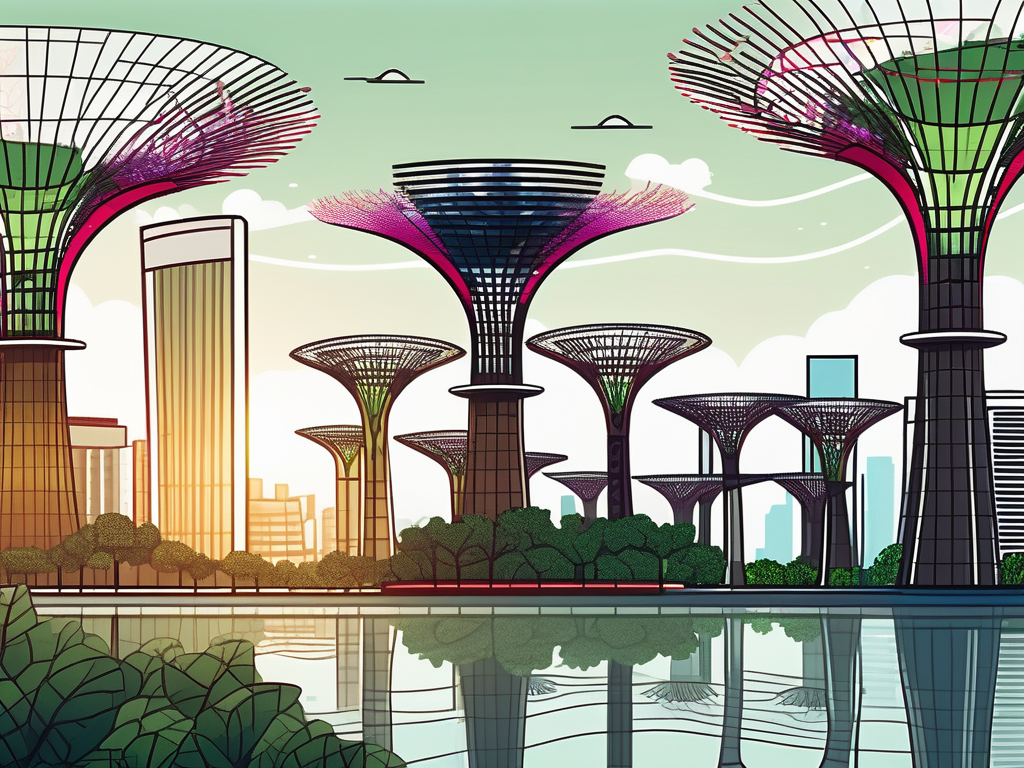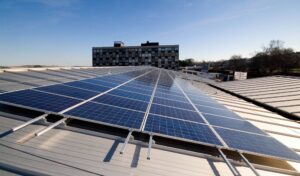
A Comprehensive Guide to Different Types of Solar Panels in Singapore
When it comes to sustainable energy solutions, solar panels have gained significant popularity in recent years. In Singapore, the use of solar energy is growing rapidly, with more homeowners and businesses opting for this renewable energy source. In this comprehensive guide, we will explore different types of solar panels available in Singapore, their working principles, and factors to consider when choosing the most suitable option for your needs.

Introduction to Solar Panels
Solar panels are composed of several key components that work together to convert sunlight into electricity.
Solar panels are a crucial part of the renewable energy revolution. As the world continues to grapple with the effects of climate change, solar panels offer a sustainable and clean solution to meet our energy needs. By harnessing the power of the sun, solar panels provide a renewable source of electricity that can reduce our reliance on fossil fuels and decrease harmful greenhouse gas emissions.
| Type of Solar Panel | Efficiency | Construction | Materials |
|---|---|---|---|
| Monocrystalline Solar Panels | Approximately 20% | Made from single silicon crystals, 60 to 72 solar cells | High silicon purity |
| Polycrystalline Solar Panels | Around 15 to 17% | Made from multiple silicon crystals, blue speckled appearance | Silicon fragments cooled and sliced into wafers |
| Thin-Film Solar Panels | Between 10 and 13% | Lightweight and flexible, cells about 350 times thinner than other types | Thin layer of photovoltaic material (silicon, cadmium, copper, dye-sensitised) |
Basic Components of Solar Panels
The main components of solar panels include photovoltaic cells, also called solar cells, which are responsible for converting sunlight into direct current (DC) electricity. These cells are made up of semiconductor materials, such as silicon, that have the ability to absorb photons and release electrons. The electrons flow through the cell, creating an electrical current.
In addition to the photovoltaic cells, solar panels also require other essential components to function effectively. An inverter is one such component, which converts the DC electricity produced by the solar cells into alternating current (AC) electricity. AC electricity is the type of electricity used in homes and businesses, making the inverter a crucial part of the solar panel system.
Furthermore, a mounting system is necessary to position the solar panels optimally. The mounting system ensures that the panels are angled correctly to maximize sunlight absorption and efficiency. It also provides stability and protection against environmental factors such as wind and snow.
How Solar Panels Work
The process of converting sunlight into usable electricity involves several steps. When sunlight hits the solar panels, the photovoltaic cells absorb the photons (light particles) and release electrons. These electrons produce an electrical current, which is then harnessed and converted into electricity that can be used to power appliances or stored for future use.
It is fascinating to think about the intricate process that takes place within a solar panel. The photons from the sun’s rays excite the electrons in the semiconductor material of the solar cells, causing them to break free from their atoms. These free electrons then flow through the cell, creating a flow of electricity. The electrical current is then directed through the wiring of the solar panel system, where it can be used to power various devices or stored in batteries for later use.
One of the remarkable aspects of solar panels is their ability to generate electricity even on cloudy days. While direct sunlight provides the most optimal conditions for solar panel efficiency, even diffused sunlight can still produce a significant amount of electricity. This means that solar panels can continue to generate power even when the weather is not perfectly sunny, making them a reliable source of renewable energy.
Overall, solar panels are a remarkable technology that harnesses the power of the sun to provide clean and sustainable electricity. As the world continues to transition towards renewable energy sources, solar panels will play a crucial role in reducing our carbon footprint and creating a more sustainable future.
Overview of Different Types of Solar Panels
There are various types of solar panels available in Singapore, each with its unique characteristics and benefits.
Types of Solar Panels
- Monocrystalline Solar Panels: These panels have the highest conversion efficiency at approximately 20%. They are made from single silicon crystals, allowing for faster electron flow, and typically contain 60 to 72 solar cells. Their high silicon purity contributes to their efficiency and durability, making them suitable for Singapore’s climate.
- Polycrystalline Solar Panels: These are made from multiple silicon crystals, resulting in a blue, speckled appearance. They are less efficient than monocrystalline panels, with an efficiency rate of around 15 to 17%. Polycrystalline panels are formed by allowing silicon to fragment and cool, then slicing it into wafers to form the panel.
- Thin-Film Solar Panels: These panels are known for being lightweight and flexible, with an efficiency rate between 10 and 13%. They are significantly thinner than other types, with cells about 350 times thinner than those in monocrystalline and polycrystalline panels. Thin-film panels are made by placing a thin layer of photovoltaic material onto a substrate, and the materials used can include silicon, cadmium, copper, and dye-sensitised solar cells.
Concentrated PV Cell (CPV)
Concentrated Photovoltaic (CPV) technology uses lenses or mirrors to concentrate sunlight onto high-efficiency cells. CPV panels can reach efficiencies over 40%, making them ideal for large-scale installations like solar farms. However, their complex design and need for direct sunlight limit their use in residential settings.
Factors to Consider When Choosing Solar Panels
When selecting solar panels for your specific needs, several important factors should be taken into account.
Efficiency and Performance
Efficiency is a crucial consideration when choosing solar panels. Higher efficiency panels generate more electricity from the same amount of sunlight, allowing you to maximize the energy produced. Consider the available space and desired electricity output to determine the most efficient option.
Cost and Installation
- The cost of solar panel installation in Singapore varies depending on the type of roofing and the solar panel technology used. For example, installations on tiled roofs may require additional costs for scaffolding, ranging from SGD $2,000 to $6,000. In contrast, metal roofing, particularly standing seam metal roofs, can offer simpler and less expensive installation processes.
- Monocrystalline panels, being the most efficient and space-efficient, are often preferred for residential rooftop installations.
- The cost of a solar panel system for a terrace house, with around 20 solar panels and an 8 kWp system, is estimated at SGD $18,000. For semi-detached houses and bungalows, the costs can be around SGD $24,000 and SGD $36,000, respectively.
Solar Panel Market in Singapore
- As of the end of Q1 2020, Singapore had a total of 4,116 solar PV installations, with town councils and grassroots units accounting for the majority. The residential installations were around 1,308.
- The Housing & Development Board (HDB) in Singapore has been actively investing in solar panels for HDB flats, aiming to generate 540 megawatt-peak (MWp) by 2030.
- Additionally, floating solar panel systems, like the one at Tengeh Reservoir, are being developed. These systems are designed to generate clean electricity while being durable and efficient, with plans for combining them with other industrial uses.
The solar panel market in Singapore is not only addressing energy needs but also advancing towards sustainability goals, with both residential and commercial sectors actively participating. The government’s initiatives, such as the SolarNova program, are also instrumental in promoting solar energy use.
Choosing the right solar panels involves careful consideration of these factors to ensure optimal energy generation and long-term savings. By understanding the different types of solar panels available in Singapore and their unique features, you can make an informed decision and contribute to a greener future.
Singapore’s Solar Energy Potential
Despite being a densely populated city-state, Singapore has significant solar energy potential. With a tropical climate and abundant sunlight, harnessing solar energy can play a crucial role in meeting the country’s energy demands. The government has recognized this potential and implemented various initiatives and incentives to encourage the adoption of solar panels across residential and commercial properties.
One such initiative is the SolarNova program, which aims to install solar panels on public housing rooftops. By utilizing the vast rooftop space available on HDB (Housing and Development Board) flats, Singapore can maximize solar energy generation. This program not only helps to reduce carbon emissions but also allows residents to benefit from lower electricity bills through the use of solar power.
In addition to residential areas, Singapore’s commercial and industrial sectors are also embracing solar energy. Many businesses are installing solar panels on their rooftops, turning their buildings into mini power plants. The excess energy generated can be fed back into the grid, further contributing to the overall energy supply of the country.
Moreover, the government has introduced the Enhanced Solar Capability Scheme (ESCS), which provides financial incentives for businesses to install solar panels. Under this scheme, companies can receive grants and tax benefits, making the transition to solar energy more economically viable.
Another significant step taken by the government is the development of floating solar farms. As land scarcity is a challenge in Singapore, utilizing the water bodies surrounding the island for solar energy generation is a creative solution. These floating solar farms not only generate clean energy but also help to reduce water evaporation, acting as a dual-purpose infrastructure.
Furthermore, the government is actively promoting research and development in solar energy technologies. Singapore’s Solar Energy Research Institute of Singapore (SERIS) is at the forefront of solar energy innovation, conducting cutting-edge research to improve the efficiency and cost-effectiveness of solar panels. This research is essential for the continuous advancement of solar energy in Singapore and beyond.
In conclusion, solar energy plays a vital role in Singapore’s sustainable development. With its environmental, economic, and technological advantages, solar energy is a key component of the country’s energy transition. By harnessing the abundant sunlight and implementing various initiatives, Singapore is paving the way towards a greener and more sustainable future.
Additional Resources:
Solar Panel Installation in Singapore
Solar Panels for Condos
Solar Panel Price
Solar Panel Subsidies
